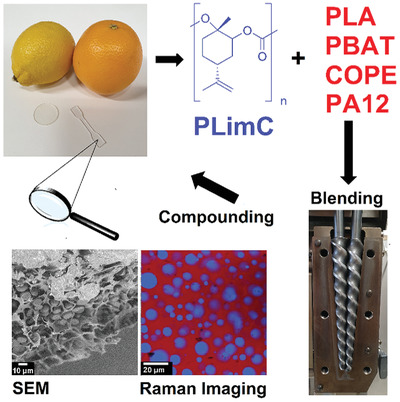News
Blends of Bio-Based Poly(Limonene Carbonate) with Commodity Polymers
12.06.2021
Simon Neumann, Pin Hu, Felix Bretschneider, Holger Schmalz, Andreas Greiner
Macromol. Mater. Eng. 2100090. https://doi.org/10.1002/mame.202100090

In this study, blends of the bio-based poly(limonene carbonate) (PLimC) with different commodity polymers are investigated in order to explore the potential of PLimC toward generating more sustainable polymer materials by reducing the amount of petro- or food-based polymers. PLimC is employed as minority component in the blends. Next to the morphology and thermal properties of the blends the impact of PLimC on the mechanical properties of the matrix polymers is studied. The interplay of incompatibility and zero-shear melt viscosity contrast determines the blend morphology, leading for all blends to a dispersed droplet morphology for PLimC. Blends with polymers of similar structure to PLimC (i.e., aliphatic/aromatic polyester) show the best performance with respect to mechanical properties, whereas blends with polystyrene or poly(methyl methacrylate) are too brittle and polyamide 12 blends show very low elongations at break. In blends with Ecoflex (poly(butylene adipate-co-terephthalate)) and Arnitel EM400 (copoly(ether ester)) with poly(butylene terephthalate) hard and polytetrahydrofuran soft segments) a threefold increase in E-modulus can be achieved, while keeping the elongation at break at reasonable high values of ≈200%, making these blends highly interesting for applications.

